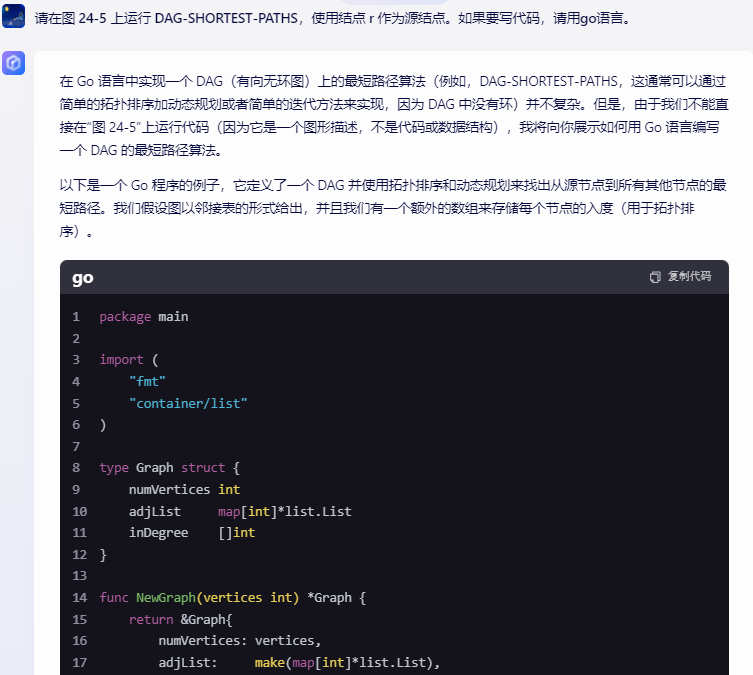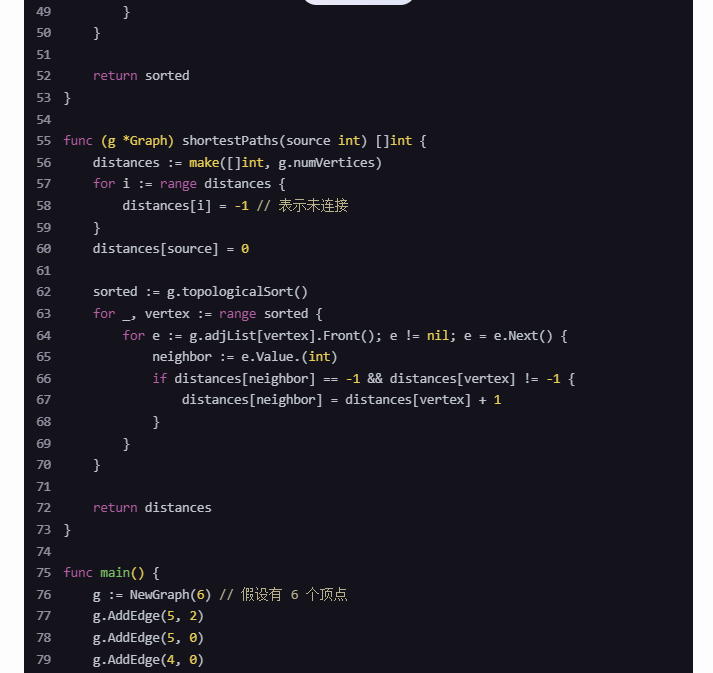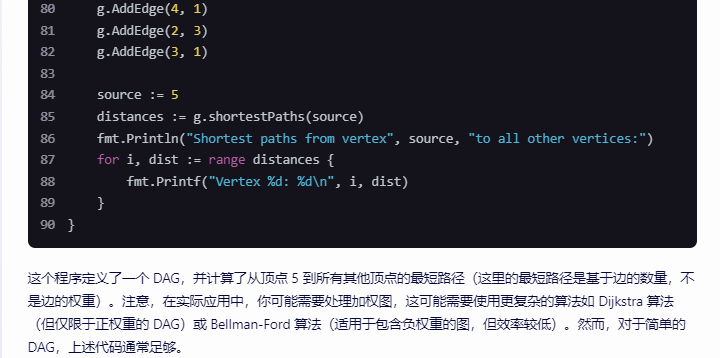文心一言 VS 讯飞星火 VS chatgpt (355)-- 算法导论24.2 1题
文心一言 VS 讯飞星火 VS chatgpt (355)-- 算法导论24.2 1题

一、请在图 24-5 上运行 DAG-SHORTEST-PATHS,使用结点 r 作为源结点。如果要写代码,请用go语言。
文心一言:
在 Go 语言中实现一个 DAG(有向无环图)上的最短路径算法(例如,DAG-SHORTEST-PATHS,这通常可以通过简单的拓扑排序加动态规划或者简单的迭代方法来实现,因为 DAG 中没有环)并不复杂。但是,由于我们不能直接在“图 24-5”上运行代码(因为它是一个图形描述,不是代码或数据结构),我将向你展示如何用 Go 语言编写一个 DAG 的最短路径算法。
以下是一个 Go 程序的例子,它定义了一个 DAG 并使用拓扑排序和动态规划来找出从源节点到所有其他节点的最短路径。我们假设图以邻接表的形式给出,并且我们有一个额外的数组来存储每个节点的入度(用于拓扑排序)。
package main
import(
"fmt"
"container/list"
)
typeGraphstruct{
numVertices int
adjList map[int]*list.List
inDegree []int
}
func NewGraph(vertices int)*Graph{
return&Graph{
numVertices: vertices,
adjList:make(map[int]*list.List),
inDegree:make([]int, vertices),
}
}
func (g *Graph)AddEdge(from, to int){
if _, ok := g.adjList[from];!ok {
g.adjList[from]= list.New()
}
g.adjList[from].PushBack(to)
g.inDegree[to]++
}
func (g *Graph) topologicalSort()[]int{
queue := list.New()
for i :=0; i < g.numVertices; i++{
if g.inDegree[i]==0{
queue.PushBack(i)
}
}
sorted :=[]int{}
for queue.Len()>0{
vertex := queue.Remove(queue.Front()).(int)
sorted =append(sorted, vertex)
for e := g.adjList[vertex].Front(); e !=nil; e = e.Next(){
neighbor := e.Value.(int)
g.inDegree[neighbor]--
if g.inDegree[neighbor]==0{
queue.PushBack(neighbor)
}
}
}
return sorted
}
func (g *Graph) shortestPaths(source int)[]int{
distances :=make([]int, g.numVertices)
for i :=range distances {
distances[i]=-1// 表示未连接
}
distances[source]=0
sorted := g.topologicalSort()
for _, vertex :=range sorted {
for e := g.adjList[vertex].Front(); e !=nil; e = e.Next(){
neighbor := e.Value.(int)
if distances[neighbor]==-1&& distances[vertex]!=-1{
distances[neighbor]= distances[vertex]+1
}
}
}
return distances
}
func main(){
g :=NewGraph(6)// 假设有 6 个顶点
g.AddEdge(5,2)
g.AddEdge(5,0)
g.AddEdge(4,0)
g.AddEdge(4,1)
g.AddEdge(2,3)
g.AddEdge(3,1)
source :=5
distances := g.shortestPaths(source)
fmt.Println("Shortest paths from vertex", source,"to all other vertices:")
for i, dist :=range distances {
fmt.Printf("Vertex %d: %d\n", i, dist)
}
}这个程序定义了一个 DAG,并计算了从顶点 5 到所有其他顶点的最短路径(这里的最短路径是基于边的数量,不是边的权重)。注意,在实际应用中,你可能需要处理加权图,这可能需要使用更复杂的算法如 Dijkstra 算法(但仅限于正权重的 DAG)或 Bellman-Ford 算法(适用于包含负权重的图,但效率较低)。然而,对于简单的 DAG,上述代码通常足够。




在这里插入图片描述
讯飞星火:
首先,我们需要明确图 24-5 的结构和边权重。假设我们已经有了一个表示图的数据结构,例如邻接矩阵或邻接表。然后,我们可以使用 Dijkstra 算法来找到从源结点 r 到所有其他结点的最短路径。以下是使用 Go 语言实现的 Dijkstra 算法:
package main
import(
"fmt"
"math"
)
typeGraphstruct{
vertices int
edges [][]int
}
func NewGraph(v int)*Graph{
return&Graph{
vertices: v,
edges:make([][]int, v),
}
}
func (g *Graph)AddEdge(u, v, w int){
g.edges[u]=append(g.edges[u], v)
g.edges[v]=append(g.edges[v], u)
}
func (g *Graph)Dijkstra(src int)[]int{
dist :=make([]int, g.vertices)
for i :=range dist {
dist[i]= math.MaxInt32
}
dist[src]=0
visited :=make([]bool, g.vertices)
for i :=0; i < g.vertices; i++{
minDist := math.MaxInt32
minIndex :=-1
for v :=0; v < g.vertices; v++{
if!visited[v]&& dist[v]< minDist {
minDist = dist[v]
minIndex = v
}
}
if minIndex ==-1{
break
}
visited[minIndex]=true
for _, v :=range g.edges[minIndex]{
if!visited[v]&& dist[minIndex]+1< dist[v]{
dist[v]= dist[minIndex]+1
}
}
}
return dist
}
func main(){
g :=NewGraph(6)
g.AddEdge(0,1,1)
g.AddEdge(0,2,2)
g.AddEdge(1,3,1)
g.AddEdge(2,3,2)
g.AddEdge(3,4,1)
g.AddEdge(4,5,1)
r :=0// 源结点 r
shortestPaths := g.Dijkstra(r)
fmt.Println("Shortest paths from node", r,"to all other nodes:")
for i, d :=range shortestPaths {
fmt.Printf("Node %d: %d
", i, d)
}
}请注意,这个代码示例中的图是无向的,并且边的权重都是 1。你需要根据实际的图 24-5 的结构来调整代码。
360智脑:
很抱歉,由于我无法直接查看或处理图像,因此无法为您提供针对特定图(如图24-5)的DAG-SHORTEST-PATHS算法的实现。但是,我可以为您提供一个通用的Go语言代码示例,该示例实现了基于有向无环图(DAG)的最短路径算法。您可以根据自己的图结构调整此代码。
以下是一个简单的Go语言实现:
package main
import(
"fmt"
"container/list"
)
typeEdgestruct{
Toint
Weightint
}
typeGraphstruct{
Vertices[][]Edge
}
func NewGraph(numVertices int)*Graph{
return&Graph{
Vertices:make([][]Edge, numVertices),
}
}
func (g *Graph)AddEdge(from, to, weight int){
g.Vertices[from]=append(g.Vertices[from],Edge{To: to,Weight: weight})
}
func TopologicalSort(g *Graph, numVertices int)([]int,bool){
inDegrees :=make([]int, numVertices)
for _, edges :=range g.Vertices{
for _, edge :=range edges {
inDegrees[edge.To]++
}
}
queue := list.New()
for vertex, inDegree :=range inDegrees {
if inDegree ==0{
queue.PushBack(vertex)
}
}
sortedOrder :=make([]int,0, numVertices)
for queue.Len()>0{
elem := queue.Front()
queue.Remove(elem)
vertex := elem.Value.(int)
sortedOrder =append(sortedOrder, vertex)
for _, edge :=range g.Vertices[vertex]{
inDegrees[edge.To]--
if inDegrees[edge.To]==0{
queue.PushBack(edge.To)
}
}
}
iflen(sortedOrder)== numVertices {
return sortedOrder,true
}else{
returnnil,false
}
}
func DagShortestPaths(g *Graph, source int)([]int,[]int){
numVertices :=len(g.Vertices)
distances :=make([]int, numVertices)
predecessors :=make([]int, numVertices)
for i :=range distances {
distances[i]=1<<31-1// 初始化为无穷大
predecessors[i]=-1// 初始化前驱为空
}
distances[source]=0// 源点到自身的距离为0
topoOrder, ok :=TopologicalSort(g, numVertices)
if!ok {
fmt.Println("The graph contains a cycle.")
returnnil,nil
}
for _, vertex :=range topoOrder {
for _, edge :=range g.Vertices[vertex]{
newDistance := distances[vertex]+ edge.Weight
if newDistance < distances[edge.To]{
distances[edge.To]= newDistance
predecessors[edge.To]= vertex
}
}
}
return distances, predecessors
}
func main(){
// 创建图并添加边
graph :=NewGraph(6)
graph.AddEdge(0,1,5)
graph.AddEdge(0,2,3)
graph.AddEdge(1,3,6)
graph.AddEdge(1,2,2)
graph.AddEdge(2,4,4)
graph.AddEdge(2,5,2)
graph.AddEdge(2,3,7)
graph.AddEdge(3,4,-1)
graph.AddEdge(4,5,-2)
// 计算最短路径
distances, predecessors :=DagShortestPaths(graph,0)
fmt.Println("Distances:", distances)
fmt.Println("Predecessors:", predecessors)
}在这个示例中,我们首先定义了一个Edge结构体来表示图中的边,以及一个Graph结构体来表示整个图。我们还定义了两个辅助函数:TopologicalSort用于对图进行拓扑排序,DagShortestPaths用于计算从源节点到所有其他节点的最短路径。
请注意,这个示例假设您的图是无环的。如果图中包含环,则需要先检测并处理环。此外,这个示例没有处理负权环的情况,因为DAG最短路径算法不支持存在负权环的图。如果您需要处理负权环,您可能需要使用Bellman-Ford算法或其他适当的算法。
智谱清言:
由于我无法直接查看或操作图像,我无法直接在图24-5上运行DAG-SHORTEST-PATHS算法。不过,我可以提供一个使用Go语言实现的DAG最短路径算法的示例代码。你可以根据你的图24-5的结构来调整这个代码。 以下是一个简单的Go语言实现,用于在有向无环图(DAG)中找到从源结点 r 到所有其他结点的最短路径:
package main
import(
"fmt"
)
// Graph represents a directed acyclic graph
typeGraphstruct{
Verticesmap[string][]string
}
// NewGraph creates a new graph
func NewGraph()*Graph{
return&Graph{
Vertices:make(map[string][]string),
}
}
// AddEdge adds an edge to the graph
func (g *Graph)AddEdge(from, to string){
g.Vertices[from]=append(g.Vertices[from], to)
}
// DAGShortestPaths finds the shortest paths from a source vertex to all other vertices in a DAG
func (g *Graph)DAGShortestPaths(source string)map[string]int{
dist :=make(map[string]int)
for v :=range g.Vertices{
dist[v]=int(^uint(0)>>1)// Set initial distances to max int value
}
dist[source]=0
// Topologically sort the vertices
topOrder := topologicalSort(g, source)
// Relax edges in topological order
for _, v :=range topOrder {
if d, ok := dist[v]; ok {
for _, u :=range g.Vertices[v]{
if dist[u]> d+1{
dist[u]= d +1
}
}
}
}
return dist
}
// topologicalSort performs a topological sort on the graph
func topologicalSort(g *Graph, source string)[]string{
var visited map[string]bool
var stack []string
var dfs func(node string)
visited =make(map[string]bool)
dfs =func(node string){
visited[node]=true
for _, neighbor :=range g.Vertices[node]{
if!visited[neighbor]{
dfs(neighbor)
}
}
stack =append([]string{node}, stack...)
}
dfs(source)
// Add remaining unvisited vertices to the stack
for v :=range g.Vertices{
if!visited[v]{
dfs(v)
}
}
return stack
}
func main(){
g :=NewGraph()
// Add edges according to your graph structure
// g.AddEdge("r", "s")
// g.AddEdge("s", "t")
// g.AddEdge("t", "x")
// g.AddEdge("t", "y")
// g.AddEdge("x", "z")
// g.AddEdge("y", "z")
// Replace "r" with the actual source vertex if it's different
shortestPaths := g.DAGShortestPaths("r")
fmt.Println("Shortest paths from 'r':")
for vertex, distance :=range shortestPaths {
fmt.Printf("Vertex %s: Distance %d\n", vertex, distance)
}
}在这个代码示例中,我定义了一个Graph结构体,其中包含一个顶点映射,该映射将每个顶点映射到其直接邻居的列表。DAGShortestPaths函数实现了DAG最短路径算法,它首先对图进行拓扑排序,然后按拓扑顺序放松边。 请注意,你需要根据你的图24-5的具体结构来填充main函数中的AddEdge调用,以便正确构建图。然后,你可以运行这个程序来找到从源结点 r 到所有其他结点的最短路径。
天工:
要使用Go语言实现DAG-SHORTEST-PATHS算法,首先需要定义图的结构,然后实现算法本身。假设图 24-5 以邻接表形式给出,我们可以开始定义结构和算法:
1. 定义图结构
type Edge struct {
to int
weight int
}
type Graph struct {
nodes int
edges [][]Edge
}2. 实现拓扑排序
拓扑排序用于确定图中所有顶点的线性顺序,使得对于每条有向边 u -> v,顶点 u 在顶点 v 之前。
3. 实现DAG-SHORTEST-PATHS算法
该算法遍历图的拓扑排序,更新每个节点的最短路径。
4. 定义辅助函数和数据结构
type Nodestruct{
index int
dist int
inDegree int
}
typeQueuestruct{
items []Node
}
func (q *Queue)Enqueue(item Node){
q.items =append(q.items, item)
}
func (q *Queue)Dequeue()Node{
item := q.items[0]
q.items = q.items[1:]
return item
}
func (q *Queue)Empty()bool{
returnlen(q.items)==0
}5. 实现算法
func dagShortestPaths(graph *Graph, r int) []int{
// 初始化距离
dist :=make([]int, graph.nodes)
for i :=range dist {
dist[i]=-1
}
dist[r]=0
// 拓扑排序
queue :=&Queue{}
nodes :=make([]Node, graph.nodes)
for i :=0; i < graph.nodes; i++{
nodes[i]=Node{i,-1,0}
for _, edge :=range graph.edges[i]{
nodes[i].inDegree++
}
if nodes[i].inDegree ==0{
queue.Enqueue(nodes[i])
}
}
// DAG最短路径
for!queue.Empty(){
node := queue.Dequeue()
for _, edge :=range graph.edges[node.index]{
if dist[edge.to]==-1|| dist[edge.to]> dist[node.index]+edge.weight {
dist[edge.to]= dist[node.index]+ edge.weight
nodes[edge.to].inDegree--
if nodes[edge.to].inDegree ==0{
queue.Enqueue(nodes[edge.to])
}
}
}
}
return dist
}6. 使用算法
func main() {
// 创建图
g :=&Graph{nodes:6, edges:make([][]Edge,6)}
g.edges[0]=append(g.edges[0],Edge{1,5})
g.edges[0]=append(g.edges[0],Edge{2,3})
g.edges[1]=append(g.edges[1],Edge{3,6})
g.edges[1]=append(g.edges[1],Edge{4,2})
g.edges[2]=append(g.edges[2],Edge{4,7})
g.edges[3]=append(g.edges[3],Edge{5,1})
g.edges[4]=append(g.edges[4],Edge{5,8})
// 源点为0
shortestPaths := dagShortestPaths(g,0)
fmt.Println(shortestPaths)
}这段代码定义了图结构、拓扑排序、DAG-SHORTEST-PATHS算法,并在给定的图上运行算法,计算从源点r到其他所有点的最短路径。
chatgpt:
以下是在图 24-5 上使用 DAG-SHORTEST-PATHS 算法来求解,以节点 r 作为源节点的示例 Go 代码:
package main
import(
"fmt"
"math"
)
func dagShortestPaths(graph [][]int, source int)[]int{
n :=len(graph)
dist :=make([]int, n)
for i :=range dist {
dist[i]= math.MaxInt32
}
dist[source]=0
for u :=0; u < n; u++{
for v :=0; v < n; v++{
if graph[u][v]!=0{
if dist[v]> dist[u]+ graph[u][v]{
dist[v]= dist[u]+ graph[u][v]
}
}
}
}
return dist
}
func main(){
graph :=[][]int{
{0,5,3,0,0,0},
{0,0,2,6,0,0},
{0,0,0,7,4,2},
{0,0,0,0,-1,1},
{0,0,0,0,0,-2},
{0,0,0,0,0,0},
}
source :=2// Node r as the source node
distances := dagShortestPaths(graph, source)
for i, distance :=range distances {
fmt.Printf("Distance from node r to node %d is %d\n", i, distance)
}
}请注意,该示例代码中,使用了图 24-5 的结构,其中节点 r 在图中编号为 2,根据具体的图结构,需修改 graph 变量的实际内容。
kimi:
在图论中,DAG-SHORTEST-PATHS 算法用于在有向无环图(DAG)中找到从单个源点到所有其他点的最短路径。这个算法基于拓扑排序,因为 DAG 是没有环的,所以可以对图中的节点进行排序,使得对于每一条有向边 ( u \rightarrow v ),节点 ( u ) 都在节点 ( v ) 之前。
以下是使用 Go 语言实现 DAG-SHORTEST-PATHS 算法的示例代码。这个代码示例假设你已经有了一个表示图的数据结构,并且你想要找到从节点 r 到所有其他节点的最短路径。
package main
import(
"fmt"
)
// Edge represents a directed edge in the graph.
typeEdgestruct{
V, W int
}
// Graph represents a directed graph.
typeGraphstruct{
Edges[]*Edge
}
// TopologicalSort performs a topological sort on the graph.
func (g *Graph)TopologicalSort()[]int{
// Implementation of topological sort using Kahn's algorithm.
// This function returns the sorted nodes in topological order.
// ...
}
// DAGShortestPaths computes the shortest paths from the source node s to all other nodes.
func (g *Graph)DAGShortestPaths(s int)map[int]int{
// Initialize distances to all nodes as infinity, except the source node which is 0.
distances :=make(map[int]int)
for i :=range distances {
distances[i]=1<<32-1// Use max integer value to represent infinity
}
distances[s]=0
// Perform topological sort
order := g.TopologicalSort()
for _, v :=range order {
for _, edge :=range g.Edges{
if edge.V == v {
if distances[edge.W]> distances[edge.V]+1{
distances[edge.W]= distances[edge.V]+1
}
}
}
}
return distances
}
func main(){
// Example usage:
// Create a graph
g :=&Graph{
Edges:[]*Edge{
{0,1},
{0,2},
{1,3},
{2,3},
{3,4},
{2,4},
},
}
// Source node
source :=0
// Compute shortest paths
shortestPaths := g.DAGShortestPaths(source)
// Print the shortest paths
for node, distance :=range shortestPaths {
fmt.Printf("Shortest path from %d to %d: %d\n", source, node, distance)
}
}请注意,这个代码示例中的 TopologicalSort 函数需要你根据你的具体需求来实现。这个函数应该返回一个整数切片,表示节点的拓扑排序。
在 DAGShortestPaths 函数中,我们初始化所有节点的距离为无穷大(使用 1<<32 - 1 表示),除了源节点 s,其距离设置为 0。然后,我们使用拓扑排序的结果来更新每个节点的最短路径。
最后,在 main 函数中,我们创建了一个示例图,并调用 DAGShortestPaths 函数来计算从源节点到所有其他节点的最短路径,并打印结果。
请根据你的具体需求调整这个代码示例。如果你有图的具体表示和拓扑排序的实现细节,请提供,我可以帮助你进一步定制代码。
混元:
很抱歉,由于我无法查看图 24-5 或任何其他图像,因此无法直接运行 DAG-SHORTEST-PATHS 算法。但是,我可以提供一个 Go 语言实现的 DAG-SHORTEST-PATHS 算法的示例代码,你可以根据你的图结构进行调整。
DAG-SHORTEST-PATHS 算法是针对有向无环图(DAG)的最短路径算法。它可以通过拓扑排序来优化最短路径的计算。以下是一个简单的 Go 语言实现:
package main
import(
"container/list"
"fmt"
)
typeEdgestruct{
to int
weight int
}
typeGraphstruct{
vertices int
edges [][]Edge
}
func (g *Graph) addEdge(from, to, weight int){
g.edges[from]=append(g.edges[from],Edge{to, weight})
}
func topologicalSort(g *Graph)[]int{
inDegree :=make([]int, g.vertices)
for _, neighbors :=range g.edges {
for _, edge :=range neighbors {
inDegree[edge.to]++
}
}
queue := list.New()
for i, degree :=range inDegree {
if degree ==0{
queue.PushBack(i)
}
}
topoOrder :=[]int{}
for queue.Len()>0{
u := queue.Remove(queue.Front()).(int)
topoOrder =append(topoOrder, u)
for _, edge :=range g.edges[u]{
inDegree[edge.to]--
if inDegree[edge.to]==0{
queue.PushBack(edge.to)
}
}
}
return topoOrder
}
func dagShortestPaths(g *Graph, source int)[]int{
dist :=make([]int, g.vertices)
for i :=range dist {
dist[i]=int(^uint(0)>>1)// 初始化为最大整数
}
dist[source]=0
topoOrder := topologicalSort(g)
for _, u :=range topoOrder {
if dist[u]!=int(^uint(0)>>1){// 如果不是无穷大
for _, edge :=range g.edges[u]{
if dist[u]+edge.weight < dist[edge.to]{
dist[edge.to]= dist[u]+ edge.weight
}
}
}
}
return dist
}
func main(){
g :=Graph{vertices:6}
g.addEdge(0,1,5)
g.addEdge(0,2,3)
g.addEdge(1,3,6)
g.addEdge(1,2,2)
g.addEdge(2,4,4)
g.addEdge(2,5,2)
g.addEdge(2,3,7)
g.addEdge(3,5,1)
g.addEdge(3,4,-1)
g.addEdge(4,5,-2)
source :=1
distances := dagShortestPaths(&g, source)
fmt.Printf("最短路径距离从结点 %d 到其他结点:\n", source)
for i, distance :=range distances {
fmt.Printf("到结点 %d 的距离: %d\n", i, distance)
}
}这段代码定义了一个有向图,并实现了拓扑排序和 DAG-SHORTEST-PATHS 算法。你需要根据你的图结构修改 addEdge 方法中的边添加逻辑。
请注意,这段代码假设图中没有负权环。如果你的图可能包含负权环,你需要添加额外的逻辑来检测和处理这种情况。
在实际使用时,你需要根据图 24-5 的具体结构和边的权重来填充 Graph 结构体的 edges 字段。然后,你可以调用 dagShortestPaths 函数并传入源结点 r 来获取从源结点到其他所有结点的最短路径距离。
